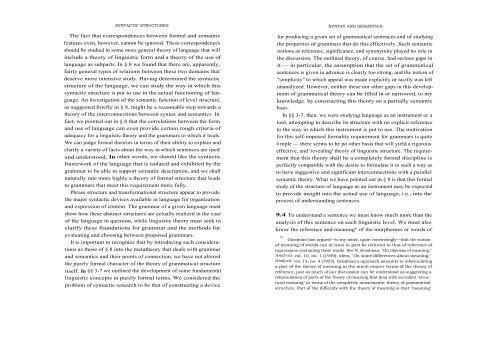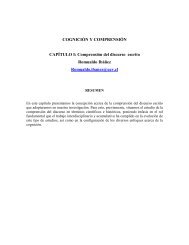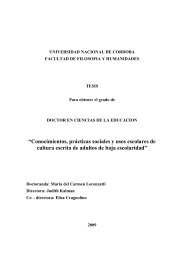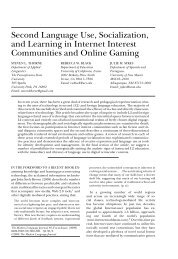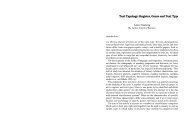Syntactic Structures
Syntactic Structures
Syntactic Structures
Create successful ePaper yourself
Turn your PDF publications into a flip-book with our unique Google optimized e-Paper software.
SYNTACTIC STRUCTURES<br />
The fact that correspondences between formal and semantic<br />
features exist, however, cannot be ignored. These correspondences<br />
should be studied in some more general theory of language that will<br />
include a theory of linguistic form and a theory of the use of<br />
language as subparts. In § 8 we found that there are, apparently,<br />
fairly general types of relations between these two domains that<br />
deserve more intensive study. Having determined the syntactic<br />
structure of the language, we can study the way in which this<br />
syntactic structure is put to use in the actual functioning of language.<br />
An investigation of the semantic function of level structure,<br />
as suggested briefly in § 8, might be a reasonable step towards a<br />
theory of the interconnections between syntax and semantics. In<br />
fact, we pointed out in § 8 that the correlations between the form<br />
and use of language can even provide certain rough criteria of<br />
adequacy for a linguistic theory and the grammars to which it leads.<br />
We can judge formal theories in terms of their ability to explain and<br />
clarify a variety of facts about the way in which sentences are used<br />
and understood. In other words, we should like the syntactic<br />
framework of the language that is isolated and exhibited by the<br />
grammar to be able to support semantic description, and we shall<br />
naturally rate more highly a theory of formal structure that leads<br />
to grammars that meet this requirement more fully.<br />
Phrase structure and transformational structure appear to provide<br />
the major syntactic devices available in language for organization<br />
and expression of content. The grammar of a given language must<br />
show how these abstract structures are actually realized in the case<br />
of the language in question, while linguistic theory must seek to<br />
clarify these foundations for grammar and the methods for<br />
evaluating and choosing between proposed grammars.<br />
It is important to recognize that by introducing such considerations<br />
as those of § 8 into the metatheory that deals with grammar<br />
and semantics and their points of connection, we have not altered<br />
the purely formal character of the theory of grammatical structure<br />
itself. In §§ 3-7 we outlined the development of some fundamental<br />
linguistic concepts in purely formal terms. We considered the<br />
problem of syntactic research to be that of constructing a device<br />
SYNTAX AND SEMANTICS<br />
for producing a given set of grammatical sentences and of studying<br />
the properties of grammars that do this effectively. Such semantic<br />
notions as reference, significance, and synonymity played no role in<br />
the discussion. The outlined theory, of course, had serious gaps in<br />
it — in particular, the assumption that the set of grammatical<br />
sentences is given in advance is clearly too strong, and the notion of<br />
"simplicity" to which appeal was made explicitly or tacitly was left<br />
unanalyzed. However, neither these nor other gaps in this development<br />
of grammatical theory can be filled in or narrowed, to my<br />
knowledge. by constructing this theory on a partially semantic<br />
basis.<br />
In §§ 3-7, then, we were studying language as an instrument or a<br />
tool, attempting to describe its structure with no explicit reference<br />
to the way in which this instrument is put to use. The motivation<br />
for this self-imposed formality requirement for grammars is quite<br />
simple — there seems to be po other basis that will yield a rigorous.<br />
effective, and 'revealing' theory of linguistic structure. The requirement<br />
that this theory shall be a completely formal discipline is<br />
perfectly compatible with the desire to formulate it in such a way as<br />
to have suggestive and significant interconnections with a parallel<br />
semantic theory. What we have pointed out in § 8 is that this formal<br />
study of the structure of language as an instrument may be expected<br />
to provide insight into the actual use of language, i.e., into the<br />
process of understanding sentences.<br />
9.4 To understand a sentence we must know much more than the<br />
analysis of this sentence on each linguistic level. We must also<br />
know the reference and meaning" of the morphemes or words of<br />
10 Goodman has argued—to my mind, quite convincingly—that the notion<br />
of meaning of words can at least in part be reduced to that of reference of<br />
expressions containing these words. See N. Goodman, "On likeness of meaning,"<br />
Analysis, vol. 10, no. 1 (1949); idem, "On some differences about meaning,"<br />
Analysis, vol. 13, no. 4 (1953). Goodman's approach amounts to reformulating<br />
a part of the theory of meaning in the much clearer terms of the theory of<br />
reference, just as much of our discussion can be understood as suggesting a<br />
reformulation of parts of the theory of meaning that deal with so-called "structural<br />
meaning" in terms of the completely nonsemantic theory of grammatical<br />
structure. Part of the difficulty with the theory of meaning is that "meaning"


